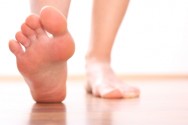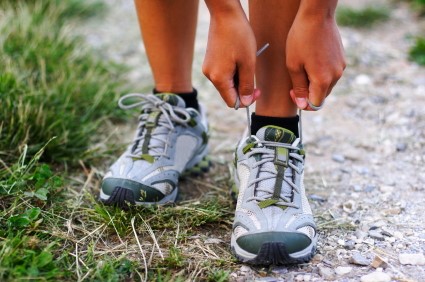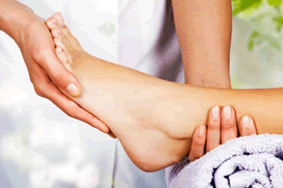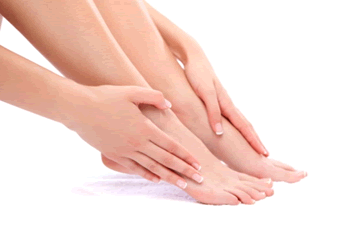
 (732) 246-1377
(732) 246-1377
 (732) 246-1377
(732) 246-1377 While there can be several different sources behind heel pain, Achilles tendonitis and Achilles bursitis are two types of heel pain that stem from inflammation in the Achilles tendon. Pain in the Achilles tendon typically results from the overuse of the heel. An increase of activity and stress to the heel can lead to tiny tears in the fiber’s tendon, making the tendon unable to repair itself. This is what ultimately leads to pain. Achilles heel pain can be treated with stretches such as the toe stretch, gastrocnemius heel drop, foot and ankle circles, and calf stretches with a towel.
While there can be several different sources behind heel pain, Achilles tendonitis and Achilles bursitis are two types of heel pain that stem from inflammation in the Achilles tendon. Pain in the Achilles tendon typically results from the overuse of the heel. An increase of activity and stress to the heel can lead to tiny tears in the fiber’s tendon, making the tendon unable to repair itself. This is what ultimately leads to pain. Achilles heel pain can be treated with stretches such as the toe stretch, gastrocnemius heel drop, foot and ankle circles, and calf stretches with a towel.
Anyone can wind up suffering from heel pain. If your heel is hurting, see Dr. Dave Poonai of Livingston Footcare. Our doctor will treat your heel pain symptoms in addition to other podiatric-related needs.
Causes of Heel Pain
● Heel pain is often associated with plantar fasciitis. The plantar fascia is a band of tissues that extends along the bottom of the foot. A rip or tear in this ligament can cause inflammation of the tissue.
● Achilles tendonitis is another cause of heel pain. Inflammation of the Achilles tendon will cause pain from fractures and muscle tearing. Lack of flexibility is also another symptom.
● Heel spurs are another cause of pain. When the tissues of the plantar fascia undergo a great deal of stress, it can lead to ligament separation from the heel bone, causing heel spurs.
Why Might Heel Pain Occur?
- Wearing ill-fitting shoes
- Wearing non-supportive shoes
- Weight change
- Excessive running
Treatments
Heel pain should be treated as soon as possible for immediate results. Keeping your feet in a stress free environment will help. If you suffer from Achilles tendonitis or plantar fasciitis, applying ice will reduce the swelling. Stretching before an exercise like running will help the muscles. Using all these tips will help make heel pain a thing of the past.
With the advancements in technology and greater knowledge of how muscles and joints work, physical therapists can turn things around dramatically.
If you have any questions please feel free to contact our office located in North Brunswick, NJ. We offer the newest diagnostic tools and technology to treat your foot and ankle needs.
Heel pain is a stressful condition that effects day to day activities. Running and walking causes stress on the heel because the heel is the part of the foot that hits the ground first. This means that the heel is taking on your entire weight. Diagnosis and treatments for heel pain can be easily found through your podiatrist.
One of the main causes of heel pain is a condition known as plantar fasciitis. The plantar fascia is a band of tissue that extends along the bottom of the foot, from the toe to the bottom of the heel. A rip or tear in this ligament can cause inflammation of these tissues, resulting in heel pain. People who do not wear proper fitting shoes are often at risk of developing problems such as plantar fasciitis. Unnecessary stress from ill fitting shoes, weight change, excessive running, and wearing non-supportive shoes on hard surfaces are all causes of plantar fasciitis.
Achilles tendonitis is another cause of heel pain. Similar to plantar fasciitis, inflammation of the Achilles tendon will cause heel pain due to stress fractures and muscle tearing. A lack of flexibility of the ankle and heel is an indicator of Achilles tendonitis. If left untreated, this condition can lead to plantar fasciitis and cause even more pain on your heel.
A third cause of heel pain is a heel spur. A heel spur occurs when the tissues of the plantar fascia undergo a great deal of stress, leading to a separation of the ligament from the heel bone entirely. This results in a pointed fragment of bone on the ball of the foot, known as a heel spur.
Treatments for heel pain are easy and effective as long as problems are addressed quickly. The most common solution is simply taking stress off the feet, particularly off of the heel. This will ease the pain and allow the tendons and ligaments to relax. In the case of both plantar fasciitis and Achilles tendonitis, icing will reduce swelling of any part of the foot and anti-inflammatory medication is highly recommended. Properly fitting your shoes and wearing heel pads or comfort insoles will also reduce the risk of developing heel pain. Stretching before and after exercises such as running will help the foot muscles prepare for stress and lower the chances of inflammatory pain. In extreme cases, relieving heel pain might require surgery. Always make sure to discuss these symptoms and treatment options with your podiatrist to keep yourself active and pain free.
 Hammertoe is a common foot condition that can develop over time, often occurring due to the extended wear of high-heeled shoes or shoes that are too small or narrow at the front of the foot. For comfort, the American Academy of Orthopaedic Surgeons recommends that shoes be a half-inch longer than the longest toe. Placing cushioned stick-on pads over hammertoes may help prevent sores, corns, or calluses from forming. Orthotic straps and splints can also help keep a hammertoe in place and help reduce discomfort..
Hammertoe is a common foot condition that can develop over time, often occurring due to the extended wear of high-heeled shoes or shoes that are too small or narrow at the front of the foot. For comfort, the American Academy of Orthopaedic Surgeons recommends that shoes be a half-inch longer than the longest toe. Placing cushioned stick-on pads over hammertoes may help prevent sores, corns, or calluses from forming. Orthotic straps and splints can also help keep a hammertoe in place and help reduce discomfort..  A runner from NY recently wrote in to The Running Doc on Daily News asking why he frequently got ankle sprains. According to The Running Doc, one of the biggest problems when it comes to ankle sprains is knowing your own body and its limits. “The instant you’re hurt ask yourself, ‘Can I keep going?’ If you can still run with the same form and stride, then go ahead. But if you start compensating, or if your biomechanics change even slightly, stop.” He goes on to mention that there is no such thing as a “sprain-prone ankle” which means patients often need to monitor themselves when it comes to their feet in order to more accurately provide a picture of the root causes of your ankle sprains.
A runner from NY recently wrote in to The Running Doc on Daily News asking why he frequently got ankle sprains. According to The Running Doc, one of the biggest problems when it comes to ankle sprains is knowing your own body and its limits. “The instant you’re hurt ask yourself, ‘Can I keep going?’ If you can still run with the same form and stride, then go ahead. But if you start compensating, or if your biomechanics change even slightly, stop.” He goes on to mention that there is no such thing as a “sprain-prone ankle” which means patients often need to monitor themselves when it comes to their feet in order to more accurately provide a picture of the root causes of your ankle sprains.
Ankle sprains are common, but need immediate attention. If you have any concerns about your potential ankle sprain contact Dr. Dave Poonai of Livingston Footcare. Our doctors will treat your foot and ankle needs.
How Does an Ankle Sprain Occur?
Ankle sprains take place when the ligaments in your ankle are torn or stretched beyond their limits. There are multiple ways that the ankle can become injured, including twisting or rolling over onto your ankle, putting undue stress on it, or causing trauma to the ankle itself.
What are the Symptoms?
● Mild to moderate bruising
● Limited mobility
● Swelling
● Discoloration of the skin (depending on severity)
Preventing a Sprain
● Wearing appropriate shoes for the occasion
● Stretching before exercises and sports
● Knowing your limits can aid in prevention
Treatment of a Sprain
Treatment of a sprain depends on the severity. Many times, people are told to rest and remain off their feet completely, while others are given an air cast. If the sprain is very severe, surgery may be required.
If you have suffered an ankle sprain previously, you may want to consider additional support such as a brace and regular exercises to strengthen the ankle.
If you have any questions please feel free to contact our office located in North Brunswick, NJ. We offer the newest diagnostic tools and technology to treat your foot and ankle needs.
 As the summer weather dies down, sandals go back into the closet as we adorn our lower extremities with warmer options such as boots. While getting a fresh pair of boots may be nice, it is important to take the proper measures to avoid blistering on the feet from these new shoes. When first wearing new boots, keep an older pair handy if possible to give your feet a rest from potential friction. Try to break in the new boot by stepping on the heel or walking around with thicker socks on. Investing in blister prevention tools can also result in a pain free boot experience.
As the summer weather dies down, sandals go back into the closet as we adorn our lower extremities with warmer options such as boots. While getting a fresh pair of boots may be nice, it is important to take the proper measures to avoid blistering on the feet from these new shoes. When first wearing new boots, keep an older pair handy if possible to give your feet a rest from potential friction. Try to break in the new boot by stepping on the heel or walking around with thicker socks on. Investing in blister prevention tools can also result in a pain free boot experience.
Blisters are prone to making everyday activities extremely uncomfortable. If you have any concerns with blisters on your feet contact Dr. Dave Poonai of Livingston Foot Care. Our doctors will treat your foot and ankle needs.
Foot Blisters
Foot blisters develop as a result of constantly wearing tight or ill-fitting footwear. This happens due to the constant rubbing from the shoe, which can often lead to pain.
What are Foot Blisters?
A foot blister is a small fluid-filled pocket that forms on the upper-most layer of the skin. Blisters are filled with clear fluid and can lead to blood drainage or pus if the area becomes infected.
How do Blisters Form?
Blisters on the feet are often the result of constant friction of skin and material, usually by shoe rubbing. Walking in sandals, boots, or shoes that don’t fit properly for long periods of time can result in a blister. Having consistent foot moisture and humidity can easily lead to blister formation.
Prevention & Treatment
It is important to properly care for the affected area in order to prevent infection and ease the pain. Do not lance the blister and use a Band-Aid to provide pain relief. Also, be sure to keep your feet dry and wear proper fitting shoes. If you see blood or pus in a blister, seek assistance from a doctor.
If you have any questions please feel free to contact our office located in North Brunswick, NJ. We offer the newest diagnostic tools and technology to treat your foot and ankle needs.
 Presidential hopeful Carly Fiorina won CNN’s republican debate on two fronts: one for her actual answers and the second for the fact that she did so wearing 3 ½ inch heels for three hours. While most women are familiar with wearing heels in everyday situations, Fiorina’s feat was that she managed to remain poised and comfortable while fielding tough questions throughout the debate, proving that it is possible to remain both serious and stylish.
Presidential hopeful Carly Fiorina won CNN’s republican debate on two fronts: one for her actual answers and the second for the fact that she did so wearing 3 ½ inch heels for three hours. While most women are familiar with wearing heels in everyday situations, Fiorina’s feat was that she managed to remain poised and comfortable while fielding tough questions throughout the debate, proving that it is possible to remain both serious and stylish.
High heels have a history for causing foot and ankle problems. If you have any concerns about your feet contact Dr. Dave Poonai of Livingston Foot Care. Our doctor will treat your foot and ankle needs.
Effects of High Heels on the Feet
High heels are popular shoes among women because they are associated with femininity. Despite their appeal, they can cause many health problems if worn too frequently.
What parts my body will be affected by high heels?
· Ankle Joints
· Achilles Tendon – may shorten and stiffen with prolonged wear
· Balls of the Feet
· Knees – heels cause the knees to bend constantly, creating stress on them
· Back – they decrease the spine’s ability to absorb shock, which may lead to back pain. Also, the vertebrae of the lower back may compress.
What kinds of foot problems can develop from wearing high heels?
· Corns
· Calluses
· Hammertoe
· Bunions
· Morton’s Neuroma
· Plantar Fasciitis
How can I still wear high heels and maintain foot health?
If you want to wear high heeled shoes, make sure that you are not wearing them every day, as this will help prevent long term physical problems. Try wearing thicker heels as opposed to stilettos to distribute weight more evenly across the feet. Always make sure you are wearing the proper shoes for the right occasion, such as sneakers for exercising. If you walk to work, try carrying your heels with you and changing into them once you arrive at work. Adding inserts to your heels can help cushion your feet and absorb shock; you can buy either full inserts or metatarsal pads.
If you have any questions please feel free to contact our office located in North Brunswick, NJ. We offer the newest diagnostic tools and technology to treat your foot and ankle needs.
For hundreds of years, women have been wearing various kinds of high-heels for mostly aesthetic reasons. Women who wear high-heels appear to be taller and to have longer and thinner legs, and the wearer’s gait and posture changes. Though high-heels have had an association with femininity and have kept them popular over the years, there are definite health problems caused by wearing them too frequently.
The motion of the ankle joints is limited when heels are worn. The ankle joint is very important to the body when it comes to walking. Because of their location, these joints have a great deal of weight put on them. Thus, it is very important to keep them as healthy as possible. The Achilles tendon is the main tendon in the ankle. Wearing high-heels too often, studies have shown, can cause the calf muscle and Achilles tendon to shorten and stiffen, which can cause problems when shoes without heels are worn.
By putting a great deal of pressure on the ball of the foot, by forcing the toes into a small toe box, high-heels can cause or may worsen many foot problems, such as corns, hammertoe, bunions, Morton’s neuroma and plantar fasciitis.
Not only does wearing very high-heels regularly have negative effects on the feet, the rest of the body can suffer as well. The knees, one of the most important joints in the entire body, can be affected by wearing high-heels. High-heels causes the knees to stay bent all the time. Also, it can cause them to bend slightly inward as well. Doctors believe that women can suffer from osteoarthritis later in life because of constantly walking like this. By limiting the natural motion of the foot during walking, high-heels also cause an increased in stress on the knees.
Similarly, the back may also be affected by high-heels because it causes the back to go out of alignment. If high-heels are worn constantly, the spine’s ability to absorb shock can cause continued back pain. They can compress the vertebrae of the lower back, and can overuse the back muscles.
However, this is not to say that high-heels can never be worn. If worn occasionally, they will not cause serious problems. They should not be worn every day in order to avoid the long-term physical health problems of the feet, knees, ankles, and back like mentioned above.
 Boston University School of Medicine recently published a study in the Annals of Rheumatology Disease and Arthritis & Rheumatology, a new classification system for gout. The classification was developed through a multistep process with help from an international group of investigators from the American College of Rheumatology and the European League Against Rheumatism. The groups conducted a study where the gold standard of identifying gout was the presence of monosodium urate crystals. This led to a decision analysis scientific approach to generate a series of domains to classify gout.
Boston University School of Medicine recently published a study in the Annals of Rheumatology Disease and Arthritis & Rheumatology, a new classification system for gout. The classification was developed through a multistep process with help from an international group of investigators from the American College of Rheumatology and the European League Against Rheumatism. The groups conducted a study where the gold standard of identifying gout was the presence of monosodium urate crystals. This led to a decision analysis scientific approach to generate a series of domains to classify gout.
Gout is a foot condition that requires certain treatment and care. If you have any concerns regarding gout, consult with Dr. Dave Poonai from Livingston Foot Care. Our doctor will assist you with all of your foot and ankle needs.
What is Gout?
Gout is a type of arthritis caused by a buildup of uric acid in the bloodstream. It often develops in the foot, especially the big toe area, although it can manifest in other parts of the body as well. Gout can make walking and standing very painful and is especially common in diabetics and the obese.
People typically get gout because of a poor diet. Genetic predisposition is also a factor. The children of parents who have had gout frequently have a chance of developing it themselves.
Gout can easily be identified by redness and inflammation of the big toe and the surrounding areas of the foot. Other symptoms include extreme fatigue, joint pain, and running high fevers. Sometimes corticosteroid drugs can be prescribed to treat gout, but the best way to combat this disease is to get more exercise and eat a better diet.
If you have any questions, please feel free to contact our office located in North Brunswick, NJ. We offer the newest diagnostic and treatment technologies for all your foot care needs.
 South African world golfer George Coetzee broke his ankle while surfing in Bali earlier this month. The world No. 65 player had just finished at a tie for seventh place at the Whistling Straights PGA Championship and had taken some time off near Bali. Coetzee posted a photo of him in a cast captioned, “I just jumped off the board and it was shallower than I thought and I twisted around on it and it popped.” While the injury seems to be the result of a freak accident, Coetzee does see himself surfing again once he is healed stating. “There’s no point in playing golf if I’m not going to be able to do other things I enjoy.”
South African world golfer George Coetzee broke his ankle while surfing in Bali earlier this month. The world No. 65 player had just finished at a tie for seventh place at the Whistling Straights PGA Championship and had taken some time off near Bali. Coetzee posted a photo of him in a cast captioned, “I just jumped off the board and it was shallower than I thought and I twisted around on it and it popped.” While the injury seems to be the result of a freak accident, Coetzee does see himself surfing again once he is healed stating. “There’s no point in playing golf if I’m not going to be able to do other things I enjoy.”
Broken ankles need immediate treatment. If you have any concerns about your feet and ankles contact Dr. Dave Poonai of Livingston Foot Care. Our doctor will treat your foot and ankle needs.
Broken Ankles
A broken ankle is experienced when a person fractures their tibia or fibula in the lower leg and ankle area. Both of these bones are attached at the bottom of the leg and combine to form what we know to be our ankle.
When a physician is referring to a break of the ankle, he or she is usually referring to a break in the area where the tibia and fibula are joined to create our ankle joint. Ankles are more prone to fractures because the ankle is an area that suffers a lot of pressure and stress. There are some obvious signs when a person experiences a fractured ankle, and the following symptoms may be present.
Symptoms of a Fractured Ankle
· Excessive pain when the area is touched or when any pressure is placed on the ankle
· Swelling around the area
· Bruising of the area
· Area appears to be deformed
If you suspect an ankle fracture, it is recommended to seek treatment as soon as possible. The sooner you have your podiatrist diagnose the fracture, the quicker you’ll be on the way towards recovery.
If you have any questions please feel free to contact our office located in North Brunswick, NJ. We offer the newest diagnostic tools and technology to treat your foot and ankle needs.